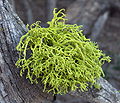Fruticose lichen
Fruticose lichen is a distinctive group of lichen species characterized by their unique growth form. Unlike other lichen types, fruticose lichens exhibit a three-dimensional, often shrub-like structure, which can be either erect or hanging. This form allows them to occupy ecological niches unavailable to other lichens, contributing significantly to biodiversity in various ecosystems.
Characteristics
Fruticose lichens are primarily identified by their branched, bushy appearance, which distinguishes them from the flat, leaf-like foliose lichens and the crusty crustose lichens. They possess a central cord or axis, around which the thallus, or body of the lichen, develops. This structure is often covered in a protective layer known as a cortex, which shields the lichen from environmental stressors. The color of fruticose lichens can vary widely, from bright greens and yellows to deep blues and purples, depending on their chemical composition and environmental factors.
Habitat
Fruticose lichens are found in a variety of habitats, ranging from arctic tundras to tropical rainforests. They are particularly prevalent in areas with clean air, as they are sensitive to air pollution. These lichens can grow on a variety of substrates, including soil, rocks, and the bark of trees, where they form symbiotic relationships with their host.
Ecological Role
The ecological role of fruticose lichens is multifaceted. They are important pioneers in some ecosystems, contributing to soil formation by breaking down rock surfaces and accumulating organic matter. Additionally, fruticose lichens serve as critical food sources for various animal species, including invertebrates and larger herbivores. They also provide nesting materials for birds and habitat for numerous microorganisms.
Reproduction
Fruticose lichens reproduce both sexually and asexually. Sexual reproduction occurs through the production of spores by the fungal partner, which must then come into contact with a compatible algal partner to form a new lichen. Asexual reproduction is more common and involves the dispersal of soredia or isidia, small clusters of algal cells surrounded by fungal hyphae, which can grow into new lichens upon finding a suitable substrate.
Conservation
Due to their sensitivity to environmental changes, fruticose lichens are often used as bioindicators to monitor the health of ecosystems, particularly air quality. However, this sensitivity also means that they are among the first organisms to suffer from environmental degradation, including air pollution, deforestation, and climate change. Conservation efforts are crucial to protect these unique organisms and the roles they play in their ecosystems.
See Also
Fruticose_lichen
Transform your life with W8MD's budget GLP-1 injections from $125.
W8MD offers a medical weight loss program to lose weight in Philadelphia. Our physician-supervised medical weight loss provides:
- Most insurances accepted or discounted self-pay rates. We will obtain insurance prior authorizations if needed.
- Generic GLP1 weight loss injections from $125 for the starting dose.
- Also offer prescription weight loss medications including Phentermine, Qsymia, Diethylpropion, Contrave etc.
NYC weight loss doctor appointments
Start your NYC weight loss journey today at our NYC medical weight loss and Philadelphia medical weight loss clinics.
- Call 718-946-5500 to lose weight in NYC or for medical weight loss in Philadelphia 215-676-2334.
- Tags:NYC medical weight loss, Philadelphia lose weight Zepbound NYC, Budget GLP1 weight loss injections, Wegovy Philadelphia, Wegovy NYC, Philadelphia medical weight loss, Brookly weight loss and Wegovy NYC
|
WikiMD's Wellness Encyclopedia |
| Let Food Be Thy Medicine Medicine Thy Food - Hippocrates |
Medical Disclaimer: WikiMD is not a substitute for professional medical advice. The information on WikiMD is provided as an information resource only, may be incorrect, outdated or misleading, and is not to be used or relied on for any diagnostic or treatment purposes. Please consult your health care provider before making any healthcare decisions or for guidance about a specific medical condition. WikiMD expressly disclaims responsibility, and shall have no liability, for any damages, loss, injury, or liability whatsoever suffered as a result of your reliance on the information contained in this site. By visiting this site you agree to the foregoing terms and conditions, which may from time to time be changed or supplemented by WikiMD. If you do not agree to the foregoing terms and conditions, you should not enter or use this site. See full disclaimer.
Credits:Most images are courtesy of Wikimedia commons, and templates, categories Wikipedia, licensed under CC BY SA or similar.
Contributors: Prab R. Tumpati, MD



